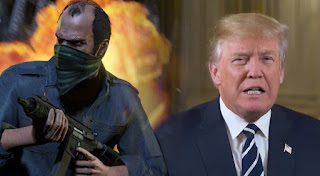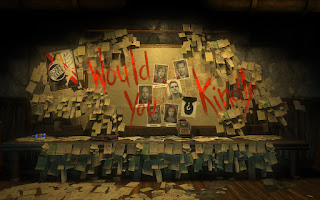Is Violence In Video Games a Problem?
Is
Violence in Video Games a Problem?
Is violence in video games a problem? It’s
a question that’s been at the heart of countless video game controversies ever
since games have had the technology to properly depict it. Anytime there’s been
a potential link between violent acts and violent video games, mainstream media
and politicians have been quick to throw the blame toward the fastest growing
industry; look no further then the Sandy Hook shooting being blamed on the
killer’s obsession with violent games. From 1992’s Mortal Combat, to boycotts of 2013’s
GTA V for allegedly promoting violence toward women, controversies surrounding
violence in the industry are nothing new.
More recently however, after the Florida
shootings earlier in March President Trump was quick to pivot the discussion
from gun control towards the possibility of restricting access to video games:
“I’m hearing more and more people say the level of violence on video games is
really shaping people’s thoughts…maybe they have to put a rating system for
that.” Despite the fact the ESRB has been rating games in America for more than
20 years.
It’s not hard to see through Trump’s
statements as nothing more then a distraction from the real problems of gun
control laws, especially since there have been countless experiments disproving
the theory that violent video games turn people violent, including a recent
study in January by the University of York citing that violent games do not
“prime” players to act aggressively.
So, is violence in video games a problem?
The science says no. What about the art of video games though? The Last Of Us uses it to convey a
message of hope and love, in a dead America surrounded by gore and anger it
makes the central relationship of the game feel like the most important thing
in the fucking world. Bioshock uses
it to make a political statement, as does GTA
V with its biting satire of the way the media views modern day America.
There are several poignant depictions of violence in video games, but t’s still
an underwhelming minority. For every game that puts violence to good use, there
are 20 games that use violence just because it looks cool. And this is
definitely undeniable. There’s a certain catharsis involved in seeing a robots
head pop after you land a perfect headshot. Violence in most games have no
weight, and it’s easy to see how people might think games desensitize people to
violence when they’re used so flippantly, so often. But as an community should we be so surprised
or even insulted when the White House releases a 90 second supercut showing off
how violent games can be. It certainly minimizes and disrespects the power that
games can have, but rarely do. So
many games include some form of violence just because they include combat as
the primary source of interaction; games that aren’t necessarily about violence
still feature it very prominently. Everything from Pokémon and Zelda to Ori and Persona are in no way about violence, but combat is still what
you’ll be doing 70% of the time. It’s easy to feel bad for developers because
there aren’t any easy fixes, combat in these games are fun, it’s the reason
most of them sell, and most importantly there aren’t many alternatives.
Franchises like Animal Crossing thrive on
their lack of combat; they’re all about the relaxation. And it’s obviously easy
to not include any sort of violence into sports/racing/puzzle games, but it’s
absolutely impossible to make a fighting game with no fighting, or a shooter
with no shooting. Even other genres like platformers such as Mario or Sonic don’t particularly need any enemies, but the threat of them
adds urgency; Mario would be half as fun if there weren’t an evil mushrooms to
avoid or rockets to dodge. But it’s also increasingly difficult for big budget
developers to experiment with their games: violence sells. With the fact that
games are becoming more expensive to make, it’s almost impossible to not ship a
£50/$60 game without violence. A recent example, Sea of Thieves is a AAA game that’s easy to imagine with no combat,
in fact I’ve seen several opinions online saying the game would be better if it
didn’t have any PvE combat, if it was just you and three friends exploring the
seas without having to worry about any enemy players chasing after you. But how
do you advertise that? How do you get a big audience to be excited about that?
How do you make a profit on that? Game development is a major risk that many
publishers and studios are understandably, unwilling to experiment with.
Ultimately, it’s hard to come to a definite
conclusion and sit firmly on one side of the fence for a question like this.
Depictions of violence in games can suck. Definitely. But it’s not necessary
for every game that includes violence to explore it with nuance or add some
kind of artistic message to the game, for the game to be a great game. Sometimes
just being fun is enough. But progress is slow and we can’t be shocked every
time Australia bans a game for their violence or a politician uses the industry
as a scapegoat. That will continue to happen until playing games become as commonplace
as watching films.










Comments
Post a Comment